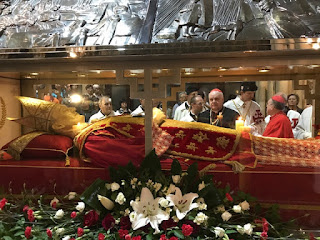WAY back on May 12-13, Cardinal O'Brien and I traveled to Zagreb, Croatia for the 1st investiture in Croatia - although the Order has a much older history and connection to the Holy Land.
Because of flight connections, we didn't arrive in Zagreb until rather late on Friday evening - so we had a bite to eat and went right to bed - as the Investiture was first thing in the morning. As the Mass began, Josip Cardinal Bozanić offered a greeting.
Then the Investitures began...
I like this photo - the Cardinal waving to all the members gathered outside...
Buried in the Cathedral in Zagreb is the body of Blessed Aloysius Cardinal Stepinac - who was the Cardinal Archbishop from 1937 until his death in 1960 - as a martyr under the Communist Regime. His story is below - in all its controversy...
He’s seen by Croatians as a national hero, but derided as a Nazi sympathizer, or worse, by his critics, prominently including many Serbs, who charge Stepinac was complicit in anti-Serb brutalities in the wartime independent state of Croatia.
That’s clearly not a view shared by recent popes. St. John Paul II described Stepinac as a man who “had the strength to oppose the three great evils of his century: Fascism, Nazism, and Communism,” during a 1998 beatification Mass.
As the youngest bishop in the world at the time, Stepinac became the coadjutor Archbishop of Zagreb in 1934. Just a few years later, the Second World War loomed over Europe and Stepinac was forced to navigate the turmoil. The record shows that he did so without aligning himself with any political party or movement, although many today unreasonably associated him with the Ustaša, a nationalist faction that arose in Croatia before and during World War II. Of course, similar accusations are also directed at Pope Pius XII, the wartime pontiff, for not “doing enough“ to condemn Nazism and fascism.
Benedict XVI obviously doesn’t buy that criticism either. During his own trip to Croatia in 2011, Benedict emphasized that “Stepinac knew how to resist every form of totalitarianism, becoming … a defender of the Jews, the Orthodox and of all the persecuted, and then, in the age of Communism, an advocate for his own faithful, especially for the many persecuted and murdered priests.”
According to the postulator for Stepanic’s sainthood cause, Monsignor Juraj Batelja, there are 40,000 pages of material ready to be revealed after the canonization. Each page contains testimonials from Stepinac’s contemporaries, including people who were poor, prosecuted and threatened, and whose lives were rescued thanks to Stepinac’s intervention.
Stepinac was a ‘persona non grata’ in the years of the Ustaša regime (1941-1945) and also a thorn in Yugoslavia’s side (1945-1991), whose leadership under Josip Broz Tito wanted a ‘national Church,’ independent of the Holy See. Tito’s Communist regime arrested Stepinac on September 18, 1946, and hauled him before a politically-staged show trial. Based on extorted statements and false testimonies, Stepinac was sentenced to 16 years in prison and forced labor, and a further five years of deprivation of all civil rights.
It’s no secret that while Stepinac was serving his sentence in Lepoglava prison (1946-1951), he was systematically poisoned with the toxic substances of cadmium, chrome, lead and arsenic. According to even the Vatican prosecutor in the cause, whose job is to try to knock down the argument for sainthood, “Stepinac’s virtues shine like the sun.” Moreover, there’s already a miracle lined up for canonization, approved by both the Vatican’s medical commission and the congregation’s theological consultors.
Despite all that, Pope Francis has decided to proceed with caution. Recently, the pope initiated the establishment of a joint working group between the Catholic Church and the Serbian Orthodox Church to air concerns about Stepinac’s life and record, in order to eliminate all doubt on the Orthodox side about his worthiness.
To be honest, the vast majority of the Croatian public was not enthusiastic about the pope’s decision. They’re well aware of the fierce propaganda campaign against Stepinac that’s been waged by representatives of the Serbian Orthodox Church, Serbian politicians, Serbian diplomacy and the Serbian media. For example, shortly after the Pope's decision, two Orthodox churches in Manhattan and Sydney and an Orthodox monastery were burned. On May 4, the New York Post quoted Orthodox who “believe the blazes … may have been set in retaliation for Pope Francis’ recent decision to postpone the canonization of Croatian Cardinal Aloysius Stepinac, an infamous Nazi supporter.”
The current Archbishop of Zagreb, Cardinal Josip Bozanić, defused the situation by saying that the pope’s decision is to be viewed as an ecumenical gesture, and a step toward the periphery – in this case, a spiritual periphery where the Church is open to discussion with everyone.
So, you can see - his cause is not an easy one and bring with it a lot of emotion on both sides of the issue.
Anyway, following the Mass was the traditional banquet where, as usual Cardinal O'Brien went table to table for photos.
 |
| The Cathedral in Zagreb - Governor General Agostino Borromeo is seen on the right. |
That evening there was a gala reception and exhibition discussing and describing the connection between Zagreb, Croatia and the Holy land.
Sunday morning we had a small private Mass at the Franciscan Monastery before heading to the plane for the return trip to Rome.














No comments:
Post a Comment